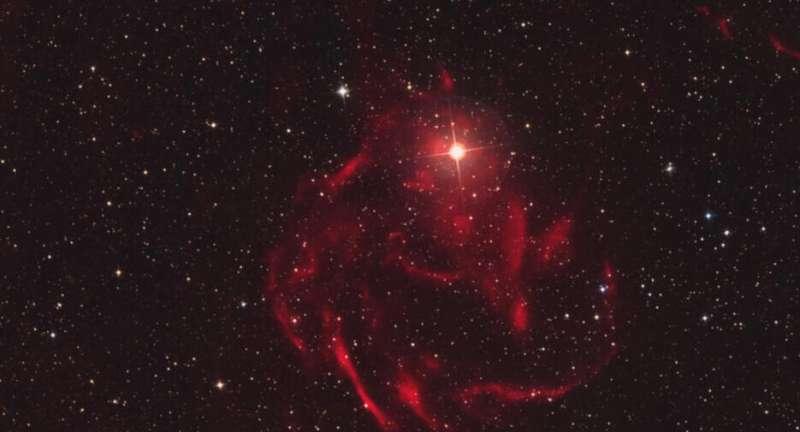
Original | Evan Gough
Translate | Linvo
Nebulae are familiar with the structure of the gas illuminated by radiation from nearby stars and are one of the most beautiful forms in nature.
With the help of amateur astronomers, an international team of astronomers discovered a new type of nebula orbiting a binary star, which they call a "galaxy emission nebula."
The binary star YY Hya is at the center of the discovery. YY Hya is a periodic variable star consisting of a K dwarf and a hot white dwarf. The two stars nestle in a layer of gas released by the star that eventually becomes a white dwarf. Before that, it went through a red giant stage when it dispersed the outer gas into space. Within this common cladding, the two stars continue to evolve as if they were separate, and the stellar radiation illuminates the diffuse gas.
Presenting the study of the discovery titled "YY Hya and Its Interstellar Environment", it was published in Astrophysics and Astronomy. The study's lead author was Stefan Kimeswenger of the Department of Astronomy and Particle Physics at the University of Innsbruck in Austria.
In a press release, Kimeswenger said: "At the end of their lives, normal stars swell into red giants. Since a large proportion of stars are binary systems, this affects their evolution at the end of their lives. In a nearby binary star system, the expanding outer parts of the star merge into a common envelope that surrounds the two stars. Within this gas envelope, however, the cores of the two stars are virtually undisturbed, following their evolution like separate single stars. ”
Previous discoveries paved the way for this discovery. Astronomers have found identically arranged binary stars, but without fully developed cladding. The reason they haven't seen it may be because of the size of the cladding.
These are H-alpha images of the galactic nebula around YY Hya.
Its cladding is very large, more than 15 light-years in diameter. Astronomers expect that at this size, the cladding will be distorted and destroyed by other stars. But YY Hya sits above the silver road surface and is not disturbed by other gas clouds.
"The main nebula is 15.6 light-years in diameter, almost 1 million times the distance from Earth to the Sun, and far greater than the distance from the Sun to its nearest star. In addition, debris up to 39 light-years away was found. Since this object is slightly higher than the Milky Way, the nebula is able to develop largely uninterrupted by other clouds in the surrounding gas," Kimeswenger said.
The size of these ordinary claddings may also hinder their discovery. This one has a larger field of view than modern telescopes. "They're too big for the field of view of modern telescopes, and they're also very weak." Moreover, their lifespans are rather short, at least on cosmic time scales, only a few hundred thousand years. ”
These are H-alpha images of the central part of the nebula, with the pink dot YY Hya in the middle.
The discovery was made by a group of amateur astronomers from France and Germany. They are studying historical astronomical images digitized in the 1980s. They found fragments of the nebula while searching for unknown objects.
They reported the discovery to experts from the Department of Astronomy and Particle Physics at the University of Innsbruck. These professional astronomers combine amateur discoveries with observations from the past 20 years and observations from various telescopes and space telescopes, including the Spitzer Space Telescope. With these data and data, astronomers at the University of Innsbruck ruled out the existence of planetary nebulae, which they first considered when they looked at the data of these amateurs.
Subsequent observations with CHILECOPE made the massive nebula clearly visible. Astronomers in the United States continue to make spectroscopic observations, providing important data for such discoveries. Existing ultraviolet images from GALAXYX, Catalina's real-time transient survey and TESS, as well as other observations from multiple sources, also form part of this hybrid.
The result?
Using all this data, the team built a model that revealed a nearby binary system. They found that the temperature of the white dwarf is about 66,000 degrees Celsius (120,000 degrees Fahrenheit), which is very hot for the white dwarf, while the temperature of the K dwarf is about 4400 degrees Celsius (8000 degrees Fahrenheit). K dwarfs have about the same mass as the Sun. The two stars orbit each other at a speed of about 8 hours, and the distance between them is only 2.2 times the radius of the Sun.
Because of its proximity, the white dwarf heats up the side of the K dwarf facing it. This heating leads to "extreme phenomena and very regular variations in brightness in the spectrum of stars." ”
Inside the gas shells ejected by the white dwarf, the two planets continue to evolve. The shell itself is very large, roughly equivalent to the mass of a sun. This makes it larger than white dwarfs and main sequence K dwarfs. According to the study, white dwarfs erupted gaseous crusts about 500,000 years ago.
This leads to another interesting possibility.
The team of astronomers speculates that the binary star is related to a new star or "guest star" seen by ancient Chinese and Korean astronomers in 1086, but this hypothesis has not been confirmed. "This galaxy is likely to be related to the nova observed by astronomers in South Korea and China in 1086." In any case, the location of the historical observations is very consistent with the objects we describe here," Kimeswenger said.
Original: https://www.universetoday.com/153925/astronomers-discover-a-totally-new-kind-of-nebula/